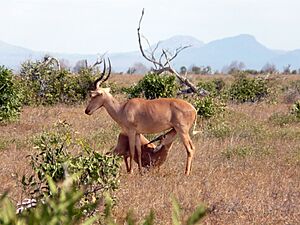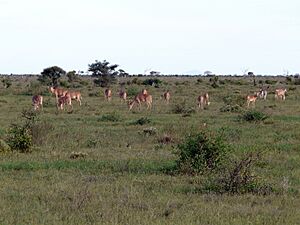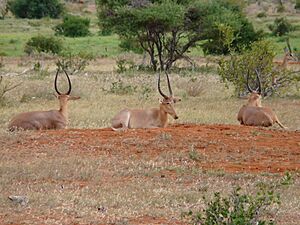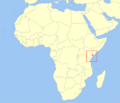Hirola facts for kids
The hirola (Beatragus hunteri), also known as the Hunter's hartebeest or Hunter's antelope, is a very rare type of antelope. Today, you can only find them in Kenya, near the border with Somalia. A big game hunter and zoologist named H.C.V. Hunter first described this animal in 1888.
The hirola is the only living member of its group, called Beatragus. Sadly, there are only about 300 to 500 hirolas left in the wild, and none are kept in zoos. Experts say that if the hirola disappears, it would be the first time a whole group of mammals has gone extinct in mainland Africa in modern history. This makes their protection extremely important.
Quick facts for kids Hirola |
|
|---|---|
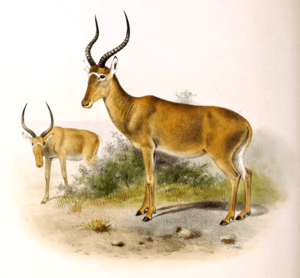 |
|
| Illustration by Philip Sclater in 1894 | |
| Conservation status | |
| Scientific classification | |
 |
|
| Range of the hirola | |
| Synonyms | |
|
Cobus hunteri Sclater, 1889 |
Contents
What Does a Hirola Look Like?
The hirola is a medium-sized antelope. Its fur is usually tan or reddish-brown, with lighter fur on its belly. Its inner ears are mostly white, and its tail is white, reaching down to its hocks (the joint on its back leg).
Hirolas have very sharp, lyre-shaped horns. These horns have ridges along most of their length. As a hirola gets older, its coat becomes darker, turning a slate gray color. Also, the number of ridges on its horns increases.
The "Four-Eyed Antelope"
Hirolas have large, dark glands below their eyes. These glands are used to mark their territory. Because of these glands, they are sometimes called "four-eyed antelopes." They also have white rings around their eyes and a white V-shape between their eyes. Their horns, hooves, nostrils, lips, and ear tips are black.
Male and female hirolas look quite similar. However, males are usually a bit bigger, have thicker horns, and darker coats.
Size and Lifespan
Hirolas stand about 99 to 125 centimeters (about 3 to 4 feet) tall at the shoulder. They weigh between 73 and 118 kilograms (about 160 to 260 pounds). Their body length can be from 120 to 200 centimeters (about 4 to 6.5 feet). Their horns can be 44 to 72 centimeters (about 1.5 to 2.3 feet) long.
We don't know exactly how long hirolas live in the wild. But in captivity, they have been known to live for up to 15 years.
Hirola Family Tree
Hirolas are part of the antelope family, in a group called Alcelaphinae. This group includes other well-known animals like hartebeest, wildebeest, and topi.
When the hirola was first discovered, it was called Hunter's hartebeest. Scientists first placed it in the same group as the topi, calling it Damaliscus hunteri. Later, some thought it might be a type of topi. However, new studies of their genes show that hirolas are unique. They are different enough from topis to be in their own special group, called Beatragus hunteri.
This unique group, Beatragus, first appeared about 3.1 million years ago. Fossils of ancient hirolas have been found in places like Ethiopia, Tanzania, and South Africa. This shows they were once much more widespread across Africa.
Where Hirolas Live and What They Eat
Hirolas are well-suited to dry places where it doesn't rain much. They live in open grasslands with some bushes or in wooded areas with low shrubs and scattered trees. They often prefer sandy soils.
Even though their homes are dry, hirolas don't seem to need much surface water to drink. They can survive without it for long periods. However, they do like to eat short, green grass that often grows near waterholes.
Hirolas mainly eat grass, but they might also eat leaves from bushes during the dry season. They prefer grasses with lots of leaves. They are not very picky eaters and can adapt to different types of grasses in their region.
Hirolas are often seen with other animals like oryx, Grant's gazelle, and zebra. They tend to avoid animals like Coke's hartebeest, buffalo, and elephants. Interestingly, hirolas seem to like grazing in areas where livestock have already eaten the grass short.
Hirola Social Life and Reproduction
Female hirolas usually give birth alone. They might stay away from the main herd for up to two months after their calf is born. This time makes them more vulnerable to predators. After a while, the mother and calf will join a "nursery herd." These herds are made up of females and their young, usually with an adult male nearby. Nursery herds can have from 5 to 40 hirolas, but they usually have about 7 to 9.
Young hirolas leave the nursery herd when they are about nine months old. They then form different temporary groups. They might gather in small groups of two or three, either all male, all female, or mixed. Young males might form "bachelor herds" with other males, which can have up to 38 individuals. Sometimes, young hirolas might even join a herd of Grant's gazelles if no other hirolas are around.
Adult male hirolas try to claim and protect their own territory, especially in areas with good food. They mark their territory using their dung, by rubbing glands under their eyes on things, and by scraping the ground with their hooves and horns.
Hirolas are seasonal breeders, meaning they have their babies at certain times of the year. Young hirolas are usually born between September and November. In captivity, a hirola pregnancy lasts about 7.5 months.
Why Hirolas Are in Danger
The reasons for the hirola's decline are complex. Many things have likely contributed to their numbers dropping so low. These include:
- Diseases: Past outbreaks of diseases like rinderpest may have harmed them.
- Hunting: Poaching (illegal hunting) is a risk.
- Drought: Long periods of dry weather make it hard to find food and water.
- Predators: They are hunted by natural predators.
- Competition: They compete with other wild animals like topi for food and water.
- Habitat Loss: Their living areas are shrinking. This can happen when too many woody plants grow, possibly because elephants (which used to clear these plants) are no longer present in some areas.
- Livestock: Hirolas sometimes use areas where farm animals graze. This can put them at risk of catching diseases from livestock, like tuberculosis.
Where Do Hirolas Live Now?
The hirola's natural home is a small area of about 1,500 square kilometers (about 580 square miles) on the border between Kenya and Somalia. However, some hirolas have also been moved to Tsavo East National Park in Kenya to help protect them.
In the 1970s, there were likely 10,000 to 15,000 hirolas in the wild. But between 1983 and 1985, their numbers dropped by a shocking 85-90%. Recent surveys estimate the population to be much smaller, around 300 to 500 individuals today.
Hirolas in Tsavo East National Park
To help save the species, some hirolas were moved to Tsavo East National Park. The first group of 30 hirolas was moved in 1963. By 1995, there were at least 76 hirolas in Tsavo. Another 29 hirolas were moved there in 1996. By 2011, the population in Tsavo was estimated to be around 76 hirolas.
In 2013, scientists put GPS collars on 9 hirolas in northeastern Kenya. This was the first time this had been done for the species in the wild. These collars help researchers learn more about how hirolas live, how they move, and how their populations are doing.
Protecting the Hirola
The hirola is listed as critically endangered, meaning it faces a very high risk of extinction. Its numbers continue to fall in the wild.
Even though they are one of the rarest antelopes, conservation efforts have been limited. The Arawale National Reserve was created in 1973 to protect them, but it hasn't been well-maintained since the 1980s.
However, there is hope! In 2005, four local communities in the Ijara District worked together to create the Ishaqbini Hirola Conservancy. By 2014, they built a special 23 square kilometer (about 9 square mile) sanctuary with a predator-proof fence. A group of 48 hirolas was moved into this safe area, and they are now breeding well inside the sanctuary. This project is a great example of how local communities can help save endangered animals.
Images for kids



